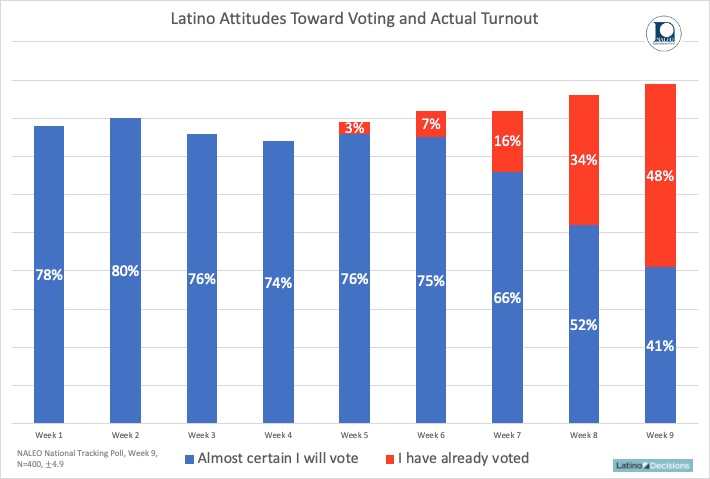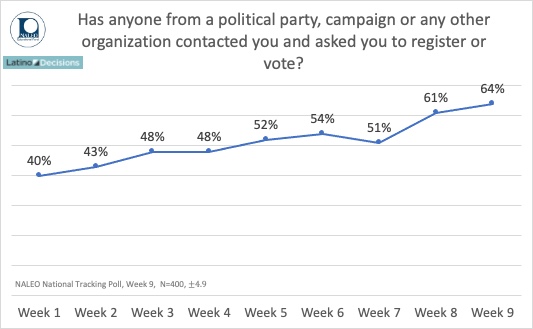On September 8, 2020 Latino Decisions and the National Association of Latino Elected Officials Education Fund launched the 2020 nine-week tracking poll of the Latino electorate. Every week leading up to the presidential election we will survey 400 registered Latinos, gaining crucial insight on the nation’s largest group of non-white eligible voters.
Throughout the 2020 presidential election, there has been a lot of hand-wringing from the left and the media about Latino voters. Early in the campaign, the media latched on to the findings of a bad poll and developed a narrative that Latino enthusiasm toward Biden and the election was low. Once again, it seemed that the so-called “sleeping giant” was going to lumber toward the ballot box and disappoint the Democrats. Most recently, the media has been saturated with stories about Latino men supporting Donald Trump. Once again, the so-called experts are scrambling for explanations, ranging from age-old stereotypes about Latino “machismo” to Stockholm syndrome-like accounts. These age-old stereotypes about Latinos (they are lazy, filled with machismo or loyal simpletons) get recycled every four years.
Thankfully, Latino social scientists with decades of experience and research are offering clear-eyed assessments of Latino voters. The Latino Decisions/NALEO tracking poll was developed to provide the public with a clear understanding of this dynamic electorate.
Let’s first turn to the question of Latino voter turnout in 2020. From the outset, over three-quarters of Latino registered voters said they were “almost certain to vote.” There was a slight dip in week four, however in the following weeks the voting data was trending upward. Halfway through the tracker, respondents started voting early and by the final week of the poll, 48 percent indicated they had already voted. In this last week, a total of 89 percent of Latinos have either voted or say they are almost certain to vote. The 11-point jump from week one to nine is dramatic. Clearly Latinos are energized, as illustrated by both the data and the images of Latinos waiting in line for hours to vote in Texas or going to the polls on horseback in Nevada. The data and on-the-ground accounts are a far cry from stories of a slumbering giant.
Another media trope that needs to be addressed revolves around Trump’s mythic Latino support. A number of news stories noted that Trump won 30 percent of the Latino vote in 2016 and his support, among Latino men in particular, was improving in 2020. This astonished many observers given Trump’s anti-immigrant rhetoric and record. However, polls with small and skewed sample sizes of Latinos tend to inflate Trump’s margin. Throughout our weekly tracker, we have been asking Latinos who they plan to vote for in 2020.
Latino vote choice has remained relatively stable throughout this election. At no point do we find Trump crossing the 30 percent threshold. Instead, Biden has improved his margins relative to Trump, and in our last week of polling, about five percent of respondents remain undecided or may vote for someone else. This remaining five percent is likely to fall in Biden’s favor given his intensified Latino outreach efforts and the new micro-targeting strategy. Developing and deploying unique messages for different segments of Latinos will likely become the gold standard in campaigns seeking to target Latinos.
In 2020, Latino voters are going to defy expectations by turning out in record numbers and giving Joe Biden and other Democrats a decisive victory. This conclusion is not merely based on the data. Nor is it merely the result of Latino opposition to Trump. Rather, Biden and the Democratic Party have been developing new targeting strategies and mobilizing Latinos in a manner that is surpassing previous campaign efforts. Latino voters have long been regarded as one of the most neglected segments of the electorate. As a young and relatively mobile group, Latinos tend to fall in the low propensity category and are typically ignored by campaigns. This creates a vicious cycle of under-mobilization and continued anemic turnout rates. The 2020 election is a game-changer for Latino voters given Biden’s new and intensified GOTV strategy. Our tracking poll documents the dramatic rise in the number of Latinos saying they have been contacted throughout the election, and 66 percent say it was the Democratic Party that is mobilizing them.
There are a lot of myths and stereotypes about Latino voters. Decades of social science research reveals that Latinos are no different than other American voters. They will support a candidate or party that shares their policy preferences and they will vote at high rates if they are mobilized. If Latino voters failed to deliver in the past, it is because candidates and parties failed them. Symbolic gestures or “Hispandering” produces lackluster results. Data from our tracking poll shows that Joe Biden understands this reality and is not about to repeat the mistakes of the past. The number of Latinos who say they have been contacted by a party, candidate or organization has increased by 24 percent over the course of nine weeks. When it comes to Latino voters, Democrats are out-contacting Republicans by a ratio of two-to-one. Like the proverbial smoking gun, the mounting evidence leads to one conclusion: Latinos are ready to deliver a decisive victory to Joe Biden and the Democratic Party.
Adrian D. Pantoja is associate dean of faculty and professor of politics at Pitzer College, and Senior Analyst with Latino Decisions.





